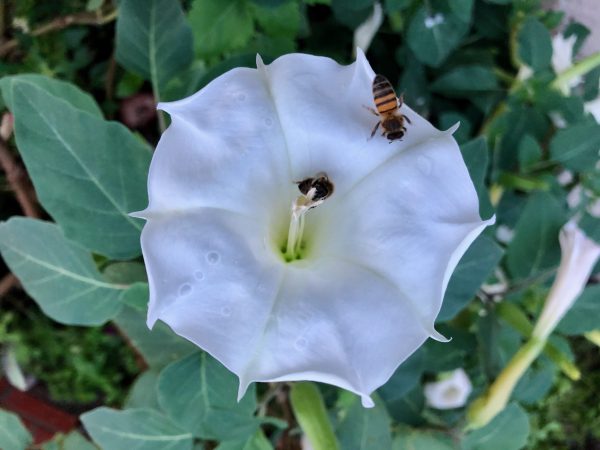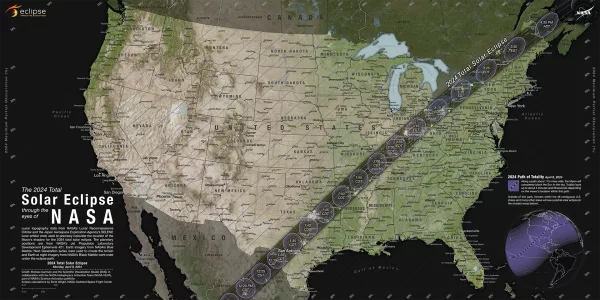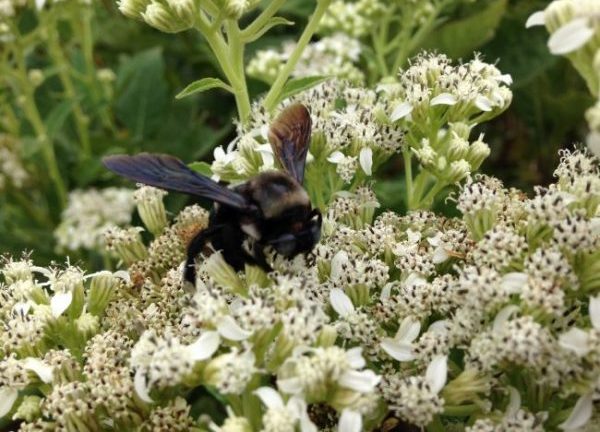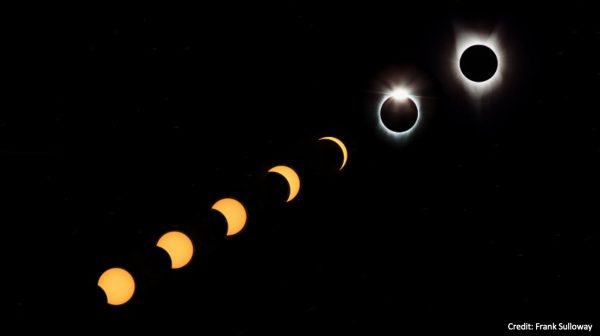Central Texas is bracing for a torrent of visitors next week as more than 100,000 people are expected to migrate to the Texas Hill Country, which sits in the path of totality of this year’s total solar eclipse.
For four and a half minutes on Monday, April 8, about 1:35 PM Central Daylight Time, the moon will completely cover the sun, temperatures will drop about 10 degrees, and animals of all kinds will respond to the midday darkness.
Scientists and others have called the event a once-in-a-lifetime opportunity. The next such eclipse won’t occur until 2045.
Local officials in the Texas Hill Country have been prepping for the event for months, encouraging residents to stock up on groceries, fill their gas tanks, and observe the spectacle in place if possible, as traffic snarls are expected.

Jimson weed, Datura wrightii, blooms at night. Will it show itself during the total eclipse? Will bees return to their hives? –Photo by Monika Maeckle
The National Aeronautics and Space Administration (NASA) is setting up shop in the Hill Country town of Kerrville, just 65 miles west of San Antonio. Other towns are staging eclipse festivals and special events.
The economic impact of the event has been estimated at $1.4 billion.
“The excitement is huge, and Texas is going to be center stage,” Dawn Larios, executive director of the West Texas Region of the Texas Restaurant Association, told the San Antonio Report.
The Texas Hill Country is well known for its diverse wildlife and contains at least 407 game and nongame species–from bobcats, rabbits and deer, to turkey, horned toads and gar. Because of its many streams and rivers and its geographic location as a flyway, it also is a favorite of migratory birds and insects.
How will wild creatures respond to the midday darkness?
We’re likely to witness nighttime behaviors, said Andrew Farnsworth, a scientist in the Center for Avian Population Studies at the Cornell University Lab of Ornithology, in a recent media briefing.
Farnsworth said crickets will start chirping, bats will emerge. Birds and other animals will cease daytime behaviors–for example, birds will settle into their roosts (unless they’re active at night like owls) and day-flying insects will land, he said.
According to a recent Washington Post article by Carolyn Y. Johnson, decades of scientific studies have demonstrated various wildlife reactions to eclipses.
For example, after a total eclipse in 1932, cockroaches raided a pantry in Massachusetts. A total eclipse in Belgium in 1999 caused sap to flow more slowly in a 75-year-old beech tree. And during a total eclipse in Mexico in 1991, orbweaver spiders started tearing down their webs while North American side-blotched lizards closed their eyes and took a nap.

Path of totality for 2024 total solar eclipse. –Courtesy NASA
Last Fall, this same stretch of the Texas Hill Country experienced an annular eclipse during peak monarch butterfly migration season. At the time, several scientists said the eclipse was unlikely to affect migrating monarchs, beyond perhaps causing them to temporarily roost.
David James, who researches California monarchs at Washington State University, said the partial solar eclipse “would certainly not affect the direction or sustainability of their migration.”
Longtime monarch butterfly researcher Karen Oberhauser agreed.
“We had a full eclipse in the Midwest a few years ago, and it didn’t seem to impact them. I don’t think they last long enough to mess up their perception of day length or any other environmental cues,” she said at the time.
“I’m guessing they will just hunker down in place,” said André Green, a scientist at the University of Michigan who’s been working on tracking monarchs with radio tags.
Bees have demonstrated detectable responses to eclipses, according to Ferhat Ozturk, an assistant professor of practice and integrative biology in the UTSA Department of Integrative Biology.
Ozturk told UTSA today that he and a team will take advantage of the unique celestial event by monitoring the university’s bee hives.
Typically, bees exit their hives when the sun comes up and go foraging for nectar to fuel their activities and for pollen to bring back to the hive. As evening comes, the bees return home. They navigate by using the polarization of sunlight, Ozturk explained.

Solitary bees will sometimes sleep in flowers overnight if they end up too far from the hive to return before dark. Photo by Monika Maeckle
“Most of them start coming back home when it gets darker. They feel the sunlight decrease. But during eclipse time if they have gone a little farther outside a five-mile radius, they’ll likely settle on a flower,” he said, adding that that bees will return to foraging once the eclipse is over.
Farnsworth said he and other scientists will be tapping into a mosaic of 143 radar stations’ data that detects meteorology and biology. In 2017, scientists used eight radar stations to track what turned out to be a decrease in the number of animals flying around.
“When we compare that to what happens during a typical sunset, you’ll notice a very, very different pattern,” he said.
Between the increase in car traffic and the possible confusion of animals, roadkill events will likely increase. Expect to see more deer, pigs, raccoons and other critters dead on the roadside, while windshields will likely see higher numbers of dead butterflies and other insects.
TOP PHOTO: Total solar eclipse, —Photo courtesy Frank Sulloway via Sciline
Related posts:
- Flower “bed” works overtime as overnight bachelor pad for solitary bees
- Peak monarch migration and partial eclipse to overlap in Texas Hill Country October 14
- IUCN revises listing of monarch butterfly from “endangered” to “vulnerable”
- Monarch migration underway as new studies suggest butterflies are “not in danger”
- Q & A : Migration studies expert Andy Davis says, for monarchs, it’s survival of the biggest
- Recent IUCN “endangered” listing creates confusion for monarch butterfly followers
- Three monarch butterflies tagged in honor of those who died recovered in Mexico
- They’re here! Drought conditions greet monarch butterflies as they arrive in Texas
- Massive arrivals of monarch butterflies in the Texas Hill Country signal 2021 migration is on
Like what you’re reading? Don’t miss a single post from the Texas Butterfly Ranch. Sign up for email delivery, like us on Facebook, or follow us on Twitter, @monikam or Instagram.


Very interesting~ Thank you!